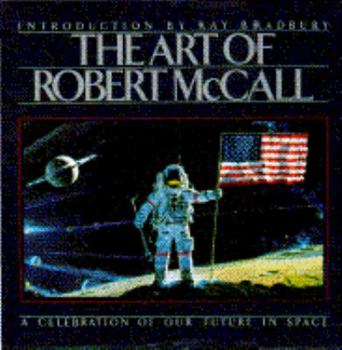The Art of Robert McCall: A Celebration of Our Future in Space
Free tracking. Charles Duke. Apollo 16. Signed Book. This description may be from another edition of this product.
Format:Hardcover
Language:English
ISBN:0553073559
ISBN13:9780553073553
Release Date:September 1992
Publisher:Spectra Books
Length:150 Pages
Weight:2.65 lbs.
Dimensions:0.7" x 11.6" x 11.4"
Related Subjects
Aeronautics & Astronautics Architecture Astronomy & Space Science Engineering TechnologyCustomer Reviews
2 ratings
Space artist
Published by Thriftbooks.com User , 16 years ago
Robert McCall is a dreamer and space explorer--not on a space craft in a spacesuit but on canvas with acrylics. McCall was the first officially appointed artist to record space endeavors for NASA. (To see the cover, please click on the title and go to the product page.) As the introduction points out, "The dawning of the space age was as profound an event as the European discovery of the Americas..." (1). McCall documented the first few years with his 16' x 72' mural located in the Johnson/NASA Space Center in Houston (as in "Houston, we have a problem" fame), entitled "Opening the Space Frontier--the Next Giant Step", 1979. It is a collage of the events of the first two decades, beginning with the first manned space flight through the space shuttle missions of the 1970's and '80's and looks ahead to permanently manned space stations. The painting that will bring your heart into your throat is "First Men on the Moon," 7' x 9' oil on canvas. It depicts Neil Armstrong and Buzz Aldrin standing on the moon, holding the American flag, the space shuttle in the background and a half-lit Earth in the sky. A magnificent painting! Remember the date June 17, 1975? McCall records this event on canvas: the the joining in orbit of the U.S. Apollo and the Soviet Soyuz during an historical lull in the Cold War. Two more events depicted by McCall as official pictorial historian are these: "Hail Columbia, April 12, 1981," marking America's return to space after half a decade of groundwork. Against a sky of a giant muted flag showing three red stripes and two stars, rises the Columbia--a stirring patriot celebration of a monumental achievement. The next page shows the Columbia landing on a runway of red and white stripes with a star-spangled sky above. McCall says of the two events: "What struck me was the contrast between the sound and the fury of Columbia's launch and the utter calm and quiet of the landing." It truly is amazing to see that he painted these exact descriptions into these works of art. In Part Two he records the projected and eventual explorations of the Moon and Mars. Related but different, a famous painting is this one: "2001," 48" x 31" and located in the National Air and Space Museum. Yes, you are right, the painting was done for the movie, "2001, Space Odyssey." Another reviewer calls the paintings in this section "science fiction," obviously accurate, but I am still claiming "space art," because many of the "events" he paints have uncannily happened. Part Three is a compilation of paintings of what he deems possible on Earth in the future, a celebration of what man can do with technology and his own humanity. This is a very optimistic collection. Part Four is his dream section where he allows his imagination free roam. He sees that we will defeat gravity to build cities in the sky. Part Five is truly visionary. The last painting in the book--"Gloria in Excelsis Deo," 12' x 22' acrylic on canvas, was commissioned by the Valley Presbyt
Imaginative and serious.
Published by Thriftbooks.com User , 24 years ago
Imaginative and serious is how I would describe this man's art, two words which rarely dance with each other in the realm of science fiction art these days.This isn't the usual science fiction art you see; it is more based on the realistically possible than the utterly impossible (exceptions being a few paintings for Star Trek and such), lying somewhere in between the strange imagery of Wayne Barlowe and the illustrations of space shuttles and planets from your childhood school textbooks.This includes various murals for NASA, science conventions, Disney's EPCOT, and even a church. Also included are some of his concept sketches and cover art for Arthur C. Clarke's 2001: Space Odyssey. While his art isn't as detailed as that of, for example, Frank Frazetta's or Richard Corben's--some of McCall's paintings seem almost possible to file under "impressionism"--he proves more imagination and dedication to the genre than either of the other two forementioned talents combined.What I like most about Robert McCall's science fiction art is, as stated earlier, it being closer to what's actually possible, while still retaining the imaginative aspects. It only makes me eager for a future which will probably come decades after my generation becomes as old as our parents, one we will never live but our children might. Another plus is the introductory paragraphs by Ray Bradbury, basically interesting musings and anecdotes about Robert McCall and science/science fiction in general.Excuse me while I go to the moon...




